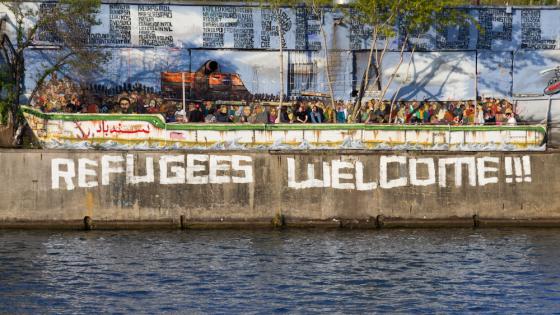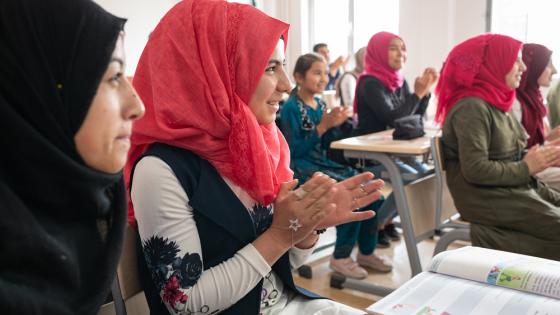About 2.4 million refugees and irregular migrants arrived in Europe in just two years from 2015 to 2016. Compared to economic migrants, refugees typically arrive in a host country with worse language skills and less locally applicable human. They are consequently likely to start at significantly lower levels of wages and employability (Brell et al. 2020, Fasani et al. 2018). Therefore, refugees are often among the most vulnerable immigrant groups, facing the steepest barriers to economic and social integration (Martén et al. 2019). At the same time, initial conditions at the time of arrival matter for successful integration and have been shown to have long-lasting effects for both refugees and economic migrants (Åslund and Rooth 2007, Bauer et al. 2014, Braun and Dwenger 2020, Fasani et al. 2020).
In a recent working paper (Aksoy et al. 2020), we provide the first systematic evidence on how initial local unemployment shaped the multi-dimensional (economic, linguistic, navigational, political, psychological, and social) integration of refugees in the context of the European refugee crisis. We focus on refugees who arrived in Germany between 2013 and 2016 and have been subsequently interviewed in the IAB-BAMF-SOEP Survey of Refugees, the largest representative survey of refugees in Europe. While refugees are eligible to enter the German labor market three months after submitting their asylum request, their labor market integration faces steep challenges. We find that among refugees aged 18 to 49 who have been in Germany for five years, only 54% of men and 17% of women are either in employment or education. These low labor force participation rates constitute a major loss both to the refugees themselves and to the receiving country. The low participation rates are even more striking considering other evidence showing that refugees in Germany are positively self-selected with respect to human capital (Aksoy and Poutvaara 2019).
Our identification relies on the exogenous placement of refugees upon arrival across counties and the fact that they cannot freely choose their place of residence for a period of at least three years. This settlement policy provides almost ideal exogenous variation to study the causal effect of initial local conditions on refugees’ integration, and is one of the factors that differentiates our work from previous studies. A further distinguishing feature of our work is the fact that we consider attitudes towards immigrants, which have not previously received much attention in the literature, as an important factor in shaping refugees’ integration. Importantly, local attitudes towards immigrants do not co-move with unemployment: the correlation between the Migrant Acceptance Index and unemployment rate is very weak (-0.19).
Main findings
Our main findings are twofold. First, we find that refugees assigned to counties with high unemployment rates are less likely to be in employment or education and less likely to be in full- or part-time employment. Furthermore, poor initial labor market conditions have a strong negative impact on refugees’ net monthly earnings and the Multi-dimensional Integration Index. Second, we find that favorable attitudes towards immigrants positively affect refugees’ labor market outcomes and their economic and social integration. The effects are considerably stronger for males. Together, these findings help us understand how conditions at the time of arrival affect refugees’ integration. They also have implications for the design of refugee allocation policies, as gains made in the first few years after arrival in the destination country have long-lasting effects.
Fiscal implications and heterogeneity
In terms of fiscal cost, our back-of-the-envelope calculations suggest that allocating 10,000 randomly selected working-age refugees to a county with a one standard deviation lower unemployment rate would generate annual savings of more than €2 million. To look beyond average effects, we use a machine learning classifier algorithm (causal forest) to investigate treatment heterogeneity. We find that our results are driven by older people and those with secondary or tertiary education.
Conclusions and policy implications
Our results highlight the importance of initial conditions for facilitating refugee integration. They also have implications for the design of refugee allocation policies. Although there is a strong political argument in favor of allocating refugees across the whole country, our results suggest that these policies come at a significant cost for subsequent integration outcomes for those refugees placed in worse performing and less welcoming regions. One possible way to address these concerns, while maintaining the principle of allocating refugees across the country, would be to change the weighting scheme such that the integration capacity of different states plays a larger role. One possibility for Germany would be to replace the component that is related to state population with a component related to unfilled job vacancies.
Our findings also have implications for refugee policy at the European level. Many EU member states, notably Germany, have called for a system in which asylum seekers would be reallocated across EU member states. Our findings suggest that, in addition to political difficulties (inflaming tensions between EU member states and potentially resulting in a populist backlash in those countries that are unwilling to host a larger number of asylum seekers), such a quota system could result in worse integration outcomes across the EU, as refugees placed in regions with high unemployment and negative attitudes towards immigrants would face a risk of worse subsequent economic and social integration.
References
Aksoy, C G, P Poutvaara and F Schikora (2020), “First Time Around: Local Conditions and Multi-dimensional Integration of Refugees ”, IZA Discussion Papers (13914).
Aksoy, C G and P Poutvaara (2019), “Refugees’ and Irregular Migrants’ Self-Selection into Europe: Who Migrates Where?”, IZA Discussion Papers (12800).
Åslund, O and D-O Rooth (2007), “Do When and Where Matter? Initial Labour Market Conditions and Immigrant Earnings”, The Economic Journal 117 (518): 422–448.
Bauer, T, S Braun, M Kvasnicka (2014), “The Economic Integration of Forced Migrants: Evidence from Postwar Germany”, VoxEU.org, 24 February.
Braun, S and N Dwenger (2020), “Resettlement Location Significantly Affects Integration Outcomes of Forced Migrants”, VoxEU.org, 19 May.
Brell, C, C Dustmann and I Preston (2020), “The Labor Market Integration of Refugee Migrants in High-income Countries”, Journal of Economic Perspectives 34 (1): 94–121.
Fasani, F, T Frattini and L Minale (2020), “The Scarring Effects of Employment Bans for Asylum Seekers”, VoxEU.org, 09 June.
Fasani, F, T Frattini and L Minale (2018), “(The struggle for) refugee integration into the labour market: Evidence from Europe”, VoxEU.org, 09 April.
Martén, L, J Hainmueller and D Hangartner (2019), “Ethnic Networks Can Foster the Economic Integration of Refugees”, Proceedings of the National Academy of Sciences 116 (33): 16280–16285.






